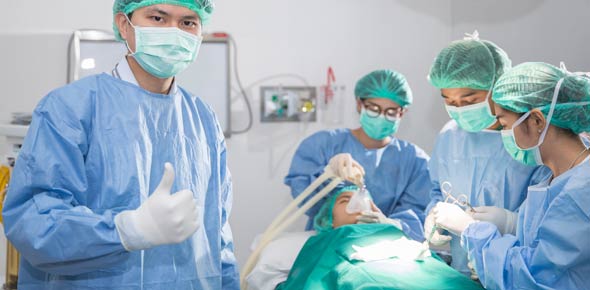The use of noninvasive high-energy shock waves to pulverize gallstones...
Which is the antiseptic solution of choice for a skin prep?
Bariatric surgery treats
When are counts done in the OR?
Labor can be induced using
The needle used to instill the gas during a laparoscopy is a
Which item retracts the spermatic cord structure in herniorrhaphy?
Which of the following actions by the scrub person is NOT an...
The fallopian tube is grasped with a
Intra-abdominal pressure during the instillation of CO2 for creation...
What would an anterior and posterior repair accomplish?
The proper method of removing the gallbladder specimen after complete...
Gastrointestinal decompression during a general surgical procedure can...
What special technique is employed during a hysterectomy?
Which drug is given to aid in placental expulsion?
Pelviscopy differs from laparoscopy in the
Intraoperative cholangiograms can be performed either through open...
A procedure done to give the colon a rest and is then reversed is
A device that may obviate the need for an abdominoperineal resection...
As grossly soiled instruments are returned to the scrub, they should...
When the scrubperson is draping a nonsterile table, he or she must
The main purpose of the skin prep is to
Which structure(s) are identified and preserved in thyroid surgery?
After uterus removal in a hysterectomy
When handling uterine curettings
A Hulka forceps is used in
An incision made during normal labor to facilitate delivery with less...
A technique employed for cervial biopsy is
At which point in a cesarean is a bulb syringe used?
Needle aspiration of the cul-de-sac is surgically termed
When covering a Mayo stand, the scrubperson should
In laparoscopy, tubal patency is checked by
A gastroplasty
Blunt dissection of the gallbladder from the sulcus of the liver...
All of the following drains are considered active postoperative drains...
The procedure that provides visualization of the internal contour of...
When both direct and indirect hernias occur in the same inguinal area,...
A procedure done on young women who evidence benign uterine tumors but...
Direct visualization of the common bile duct is accomplished with a
Which bone is transected with bone-cutting forceps before removal of a...
While balancing a video camera in endoscopy requires the scrub person...
A Foley catheter is placed into the presurgical hysterectomy patient...
In a thyroidectomy, a loop retractor retracts the
Oxytocics are given in a cesarean after the baby's shoulders are...
An irreducible hernia whose abdominal contents have become trapped in...
Which type of endoscopy camera procedures the truest color?
Drainage of an incision following a simple or modified radical...
A Humi cannula is used in
An endoscopic approach to pelvic and intraabdominal examination is
"Scratch" marking is done in surgery of the
What suture would be placed into the wall of a large ovarian cyst...
During a laparoscopic cholecystectomy the surgeon generally stands
The maximum pressure allowed to prevent the possible intraoperative...
Soiled sponges are
A procedure to prevent cervical dilatation that results in release of...
An endoscopic investigation of the uterus and tubes is a
Cervical carcinoma is situ can be classified as
An enterocele differs diagnostically from a rectocele by its...
An advanced inflammation of the bowel could be conservatively treated...
Specimens may be passed off the sterile OR table by the scrub person...
Defogging the video camera is usually responsibility of the
Which incision would require cutting through Scarpa's fascia?
Cervical conization is accomplished using all of the following EXCEPT
Sterility can be accomplished by all of the following procedures...
If a sterile field becomes moistened during a case
Fogarty biliary catheters are used to
All of the following are designated options of laparoscopic hernia...
During surgery, towel clips
To confirm the diagnosis of ectopic pregnancy, it is sometimes...
An inguinal hernia containing a Meckel's diverticulum is called a
The most commonly identified ovarian cyst is the
Which of the following instruments would be used to grasp the anterior...
Conization of the cervix may be accomplished by all of the following...
Intraoperative chromotubation can be effected by all of the following...
A selected alternative to a conventional ileotomy that denies...
An alternative to abdominal hysterectomy utilizing an endoscope is...
Extrauterine pregnancies can occur in the
A vesicourethral abdominal suspension is known as a
Papanicolaou indicates
In a cesarean birth, the uterus is opened with a knife and extended...
What gynecologic setup would include various sizes of sterile...
A holding instrument not found in a vaginal procedure is a
Reconstruction of the fallopian tube setup would include
All of the following are recommendations for actions necessary to...
Laparoscopic tubal occlusion can be effected by all of the following...
A condition causing leakage of urine into the vagina is a (n)
During laparoscopic cholecystectomy, the camera operator usually...
The aim of stress incontinence operations includes all of the...
A scheduled procedure whose ultimate surgical goal involves abdominal,...
A Stamey endoscopic procedure is performed to
The hysteroscopy may be used to identify or remove all of the...
Which muscles are incised in the midline of the neck once the skin...
A herniation of the cul-de-sac of at the Pouch of Douglas is a (n)
When closing a uterus in a cesarean, the edges of the uterine incisin...
What is the preferred procedure for recurrent or persistant carcinoma...
A palliative invasive procedure done to prevent malnutrition or...
Reconstruction of the cervical canal is called
Laparoscopic tubal occlusion may utilize all of the following methods...
What is the name given to a radical vaginal hysterectomy?
What surgical procedure provides obilteration of the vagina by...
















